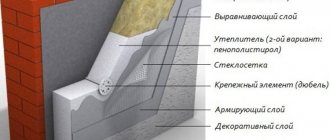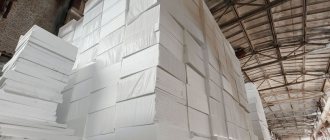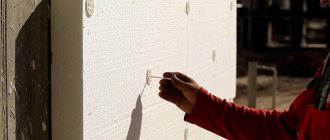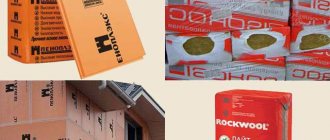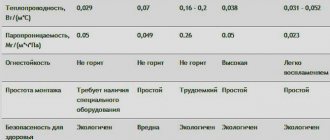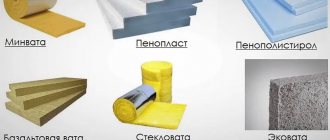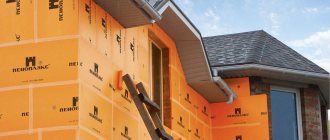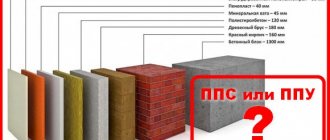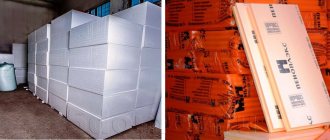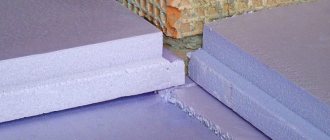If you plan to spend a little money on insulating your home, then most people decide what is better for this: foam plastic or penoplex. Both materials are considered reliable and high quality. They can be used for a long time without the risk of deformation. They do not absorb water very well, which is an important advantage.
Which is better: foam plastic or penoplex?
Expert opinion: Afanasyev E.V.
Chief editor of the Stroyday.ru project. Engineer.
Let's jump ahead a little; be sure to calculate the minimum thickness of house insulation with different insulation materials in your region using a special calculator.
Comparison of penoplex and polystyrene foam
These are two fairly cheap and popular materials. They are easy to install. However, you need to understand what the difference is in order to choose the most appropriate option.
Production
Polystyrene foam is produced by treating polystyrene granules with steam. Thus, their volume increases almost 10 times. They are glued together, so the material is of sufficient quality, which is easy and pleasant to work with. There are small voids between the granules. It is necessary to choose high-density foam for insulation.
Foam sheets can be of different thicknesses
Penoplex is produced by extrusion of polystyrene foam. This material is evenly pressed at high temperature to obtain insulation with good density. It is higher than that of foam plastic. But it also weighs more.
Important . Both insulation materials are sold in sheet form. However, it is easier for the manufacturer to fulfill an individual order for polystyrene foam if it is necessary to create a slab of a specific non-standard size. In the case of penoplex, you must have a special press of the required size.
Thermal conductivity
This is the most important parameter. It determines how much heat the room will lose when using a particular material. It is required that it be minimal. However, the insulation materials under consideration have average thermal conductivity, therefore, when using them, it is strongly recommended to create a layer on the outside and inside. This will reduce the cost of heating your home.
The foam has a lot of free space between the granules. This means that heat will pass through them. Therefore, the main indicator of this insulation is lower.
Practice shows that to obtain the same effect it is necessary to use approximately 25% more polystyrene foam than penoplex
Expert opinion: Afanasyev E.V.
Chief editor of the Stroyday.ru project. Engineer.
How to insulate walls with foam plastic yourself? More details in a special article.
Moisture permeability and vapor permeability
These are two more important parameters on which the quality of room insulation depends. If we consider the properties of both materials, it turns out that penoplex is better. It has a water absorption rate of 0.35%, while polystyrene foam has about 2%.
As for vapor permeability, both insulation materials have approximately the same performance. Penoplex - 0.013 mg/mchPa, polystyrene foam 0.05 mg/mchPa. This means that it is necessary to additionally use a high-quality ventilation system when using these materials.
Reviews about polystyrene foam insulation
“I insulated the ceiling myself with penoplex. This is how it happens - a warm flow of air rises, but due to the fact that there is a layer of insulation there, it does not cool down. Therefore, heat is saved significantly. And you don’t need to hire anyone to do the repair work, you did it yourself. Personally, I'm happy with everything. The house is warm and very pleasant to be in.”
Victor, Smolensk
“A year ago, I first insulated the floor and then the ceiling in the house. I didn’t touch the outer walls yet - I decided to see how it would hold up. There is an effect - in winter the thermometer rose to 25, instead of the usual 20, with the same gas consumption. That's why I'm happy. The floor, of course, has become a little higher, by some 5-6 cm, but now it’s not cold to walk on it without slippers. So my feedback is only positive.”
Dmitry, Belgorod
“You know what’s amazing is the amount of advertising, and negative advertising at that.
Apparently, manufacturers of more expensive materials are afraid of competition. So they are trying to prove that their material is better. I doubted for a long time whether to insulate the ceiling in the entire house with penoplex. At first I thought of making it out of plasterboard; I even covered the ceiling in one room. But plasterboard, firstly, is more expensive, and secondly, all these metal frames, again, the ceiling lowers. That’s why I bought penoplex and insulated it with it. Cool, that's fair! Fast and easy. I sealed the seams, putty on top, painted - everything is ready. It’s warm and good in the house. There is no smell of fungus on the walls. That’s why I’m very pleased.” Gennady Omsk
Advantages and disadvantages of materials
Table. Pros and cons of materials
| Material | Advantages | Flaws |
| Styrofoam |
|
|
| Penoplex |
|
|
polystyrene foam 15
comparison table
Many people find it difficult to decide which material to use for insulation: polystyrene foam or penoplex.
A comparative table of insulation materials will help you decide which is better.
| Properties | Styrofoam | Penoplex |
| Density (kg/m³) | 11-40 | 25-47 |
| Compressive Strength(MPa) | 0,05-0,16 | 0,2 |
| Flexural strength (MPa) | 0,7 | 0,5 |
| Water absorption (%) | 1-2 | 0,5 |
| Thermal conductivity (W/m•°C) | 0,029-0,032 | 0,039 |
| Fire resistance | G3-G4 | G1-G4 |
Indicators vary depending on the type of insulation chosen. Accurate information about the characteristics of the purchased thermal insulation material is indicated in the technical documentation.
Scope and installation technology
According to the recommendations of builders who have been working in this field for a long time, these materials should be used for exterior or interior work. They are considered universal. It is best to use these insulation in the following situations:
- External wall insulation. But in this case, it is necessary to ensure that the material is sufficiently protected from moisture. Otherwise, its quality characteristics may change.
- For internal insulation. There is no need to additionally use a layer for sound insulation, since polystyrene foam and penoplex cope well with this task, among other things.
- When creating a vapor barrier layer.
- Roof insulation.
External wall insulation with penoplex.
Installation can be carried out in several ways:
- Using glue. In this case, it is necessary to glue the insulation to the surface. Builders recommend additionally using umbrella dowels for greater reliability. After the glue is applied to the surface, you need to attach the insulation to the wall. There are different adhesives available, so you need to read their instructions to ensure the best adhesion.
- By creating a ventilated façade. That is, you need to make the slats so that cells form inside. Insulation is placed in these cells. It should be packed fairly tightly. After this, the top layer is applied. It is strongly recommended to use this technology only for internal insulation.
Installation of foam plastic with glue
A special article described in detail how to insulate walls with penoplex, what materials and tools will be needed.
This is the most important information regarding these insulation materials. But it is also worth considering popular manufacturers so that you can buy high-quality material that meets safety requirements.
Important . All building materials must have a fire safety certificate. It is available upon request. If it is missing, then it is better to refrain from purchasing from a specific manufacturer or supplier.
What to look for when choosing
Extruded polystyrene foam Penoplex is produced in the form of slabs of various markings - Penoplex 35, 31, 31С, 45С, 45, 75. Moreover, recently the marking of slabs 35, 31, 31С has been replaced by new types:
- 35 (without fire retardants) - Penoplex-Foundation;
- 35 — Penoplex-Roof;
- 31 - Penoplex-Wall;
- 31C - Penoplex-Comfort.
The average consumer is unlikely to be interested in super-dense slabs marked 45C, 45, 75 to solve pressing insulation problems.
Plates with increased strength are used for thermal insulation of load-bearing structures of buildings and structures, road surfaces, for loaded structures and airfield runways. The thickness of the slabs is 40, 50, 60, 80 and 100 mm, and the size is 600 by 2400 mm.
Therefore, the question of choosing between the materials expanded polystyrene and penoplex 45 or 75 is raised only on an industrial scale.
An ordinary buyer, as a rule, needs to choose one of two options - expanded polystyrene or penoplex 35? Or, in light of the latest innovations from the penoplex manufacturer - Penoplex-Foundation, Penoplex-Roof, Penoplex-Wall and Penoplex-Comfort.
The new labeling of thermal insulation boards speaks for itself here. Extruded polystyrene foam or Penoplex 35 is divided by the manufacturer into two types - without the use of special treatment to reduce flammability for Penoplex-Foundation and with impregnation with fire retardants for Penoplex-Roofing.
Expanded polystyrene Penoplex-Comfort is the most versatile brand of material. The slabs are used for thermal insulation of balconies and loggias, roofs, walls, plinths, foundations and floors, as well as insulation of garages and outbuildings.
The almost complete waterproofness of the slabs makes it possible to use them for thermal insulation of bathhouses, saunas and swimming pools with high levels of humidity. The thickness of the slabs is 20, 30, 40, 50, 60, 80 and 100 mm, and the size is 600 by 1200 mm.
Prices
The production of both expanded polystyrene and penoplex is quite cheap. What is their retail price?
The price of extruded polystyrene foam and penoplex with the most minimal parameters (density, thickness, quantity per package) starts from 1000 rubles, respectively. and 1200 rub. per package. Conclusion - the brand name of various manufacturers also matters when choosing and purchasing insulation.
Penoplex turned out to be the most expensive insulation among all brands of extruded polystyrene foam. And with an increase in the characteristics of heat-insulating boards of different brands, the price correspondingly increases further - up to 3,000 rubles. and 4200 rub.
The cost of expanded polystyrene (foam) also depends on the physical characteristics and manufacturer and is in the range of 1000 - 3000 rubles. per package. The price of penoplex and expanded polystyrene on the building materials market is slightly different in favor of the latter.
The small price difference between expanded polystyrene and penoplex is most likely due to the more complex manufacturing technology of penoplex. or maybe the seller’s trade markup is too high.
For external walls
For external insulation of the walls of a new building, it is better to use penoplex because:
- stronger, not afraid of moisture;
- immune to physical and biological stress;
- Suitable for brick, concrete, wood surfaces.
Photo: house sheathing with penoplex
It is better to choose models with fire-resistant impregnation, which significantly reduce the risk of ignition of the material.
Finishing from foam beads is considered a budget option, however, to obtain good thermal insulation of the walls, it is advisable to purchase thick blocks. To insulate areas located at height, foam plastic is mainly used, since it is lighter, which has a positive effect on the work process.
Photo: sheathing the building with foam plastic
Regardless of the choice, both types of material require protection from ultraviolet radiation by applying putty or installing protective panels. To insulate the base or foundation, penoplex is more often used, which more effectively protects the walls from soil pressure and ground water. When finishing the foundation, the blocks are sunk 1 m below the soil freezing line.
Both types of insulation are suitable for use in any climatic conditions:
- tolerate heat and severe frosts down to -50 degrees;
- limit for foam plastic – +60 degrees;
- The maximum temperature for penoplex is +75 degrees.
When working with any type of material, it is necessary to exclude contact of the panels with acetone, since the substance destroys their structure.
Exceptions to the rules
As usual, there are exceptions in construction practice when it is impossible to apply rules that work perfectly in all other cases.
So it is in the question when we decide what is better polystyrene foam or polystyrene foam. For external wall insulation, exceptions may be made in the following cases:
- When insulation is carried out on a high base and the insulation along the wall is brought to the bottom line of the windows. In this case, it is quite reasonable to use vapor-tight insulation at the bottom of the wall.
- When we install insulation in a frame wall on a wooden or steel frame, we may not have to choose which is better, polystyrene foam or polystyrene foam. To insulate the walls on the outside, vapor-permeable insulation will be used, and on the inner layer, vapor-tight insulation will be used.
Thus, you can save at the stage of installing a vapor barrier by using a heat insulator with a minimum steam throughput as the inner layer.
Types of foam plastics according to their use in housing construction
Home builders are showing the greatest interest in using Penoplex 35 expanded polystyrene. Low-rise construction using modern technologies is interested in inexpensive and efficient building materials.
In this regard, there is a classification of foam plastics according to their scope:
- "Penoplex Wall" - a material of relatively low density, which is used to insulate walls during construction.
- "Penoplex Foundation" - material of increased strength and high waterproofing. It is used for insulating foundations, basements, septic tanks and wells.
- "Penoplex Roofing" - lightweight heat-saving material with high waterproofing properties.
- "Penoplex Comfort" - a material developed specifically for insulating the walls of apartments, loggias and balconies. Characterized by increased control over environmental friendliness.
Any brands of Penoplex comply with GOST standards and are environmentally safe.
How to untangle small knots
- This method is suitable in cases where the hair is not severely damaged and there are no complex (large) knots on the hair.
- To begin manipulation, choose a comfortable place with good lighting. The treatment is performed on dry hair, so there is no need to wet the curls.
- Take the tangle in your hand so that it is clearly visible. Start taking out one hair at a time, gradually stretching each of them to its full length. Your movements should be carried out from the tips to the roots, that is, from bottom to top.
- If you don’t have the time or patience for such activities, use a wide-tooth comb. Do not process the knot itself, carry out normal combing from the tips to the root area.
- In this case, with a comb you risk tearing the hairs. To prevent this, use special sprays or gels that make combing easier. They are marked accordingly; the products do not require rinsing.
Date: September 25, 2022
For floor
For floor insulation, only penoplex is used, since it can easily withstand the weight of furniture and other active loads. Expanded polystyrene slabs insulate, and also level and strengthen the floor.
Photo: floor insulation with penoplex
This material is often used in the installation of “warm floor” systems; it has proven itself in rooms with stable humid conditions – baths, bathrooms.
Production
These two materials are completely synthetic, but they are produced using different technologies. To produce polystyrene foam, a polystyrene or formaldehyde base is used. Substances are added to it that form foam.
These substances use air to create foam. As a result, a huge number of bubbles are formed, filled with a synthetic base. The entire process takes place under normal conditions without elevated temperatures or pressure.
After the reaction is complete, small polystyrene or formaldehyde balls remain. To make polystyrene foam, elements with a diameter of 3–5 mm are selected and pressed. The result is slabs of different thicknesses from 1–2 cm to 10 or more.
As for penoplex, it is made from ready-made polystyrene balls. The finished mass is loaded into a high-pressure oven called an extruder. Everything melts there, decreases in size and floats onto the prepared base. The result is a slab that is slightly thinner than foam would otherwise be.
